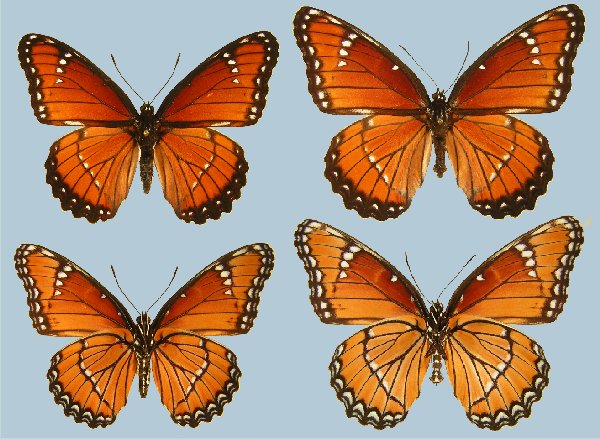Limenitis archippus obsoleta

Photo Life History: Limenitis archippus obsoleta
Habitat: Desert Washes and Rivers
Host Plants: Salix amygdaloides; Salix exigua; Salix spp.; Populus fremontii
Suitable Lab Host Plants: Any convenient willows, cottonwoods, or aspens
How to Find Female Butterflies: Click here. (L. archippus females can be found in the same habitat as the males; but can be spotty.)
How to Care for Live Female Butterflies: Nectaring techniques
Methods of Female Oviposition: High Humidity Cages; expose caged females to filtered sunlight. Potted Plant Sleeves. (Misting spraying sleeves with water a few times can affect females to lay more eggs.)
How to Find Eggs: Look on tips of leaves Females of some western U.S. populations of viceroys have been known to oviposit on very short seedlings growing very close to or even over water. Click here to watch a video of a Viceroy from Texas (nominotypical race) laying eggs in the wild. Oftentimes, in order to find eggs or caterpillars of the Arizona viceroy, you will likely get your feet wet as you walk up and down the stream or wash looking for willows draped over the water.
How to Hatch Eggs: Keep egg on original leaf. Keep humid!
How to Find Caterpillars in the Field: Look on isolated host plants growing right over or near a river; focusing on young instar perches on tips of leaves. Also, larval hibernacula can be visually conspicuous.
Caterpillar setups: Semi-closed terrariums; Potted Plant
Larva to Pupa: Caterpillar silks to leaf or twig; creates and attaches cremaster; hanging as a J before pupating.
How to Find Pupae in the Field:
Number of Broods per Year: 3-4 depending upon location.
Overwintering Stage: Third instar in hibernaculum
Overwintering Strategies: Wine Cooler; Pinning Hibernacula to host
Post-Hibernation Strategies: Well documented with this link-->Post-diapause Limenitis third instar caterpillars.
Avoiding Diapause Techniques: Expose second instar larvae to 24 hours of light! Once a first instar Limenitis molts to second instar, it begins monitoring daylength. If the daylength exceeds a certain threshold, the larva will feed to adult; else it will create a hibernaculum. Second and third instar larvae found in the wild have already made the diapause/no diapause decision. If a caterpillar builds a hibernaculum, it will need to spend the winter in the cold and brought out in the spring. (See previous two sections on overwintering strategies and post-hibernation strategies.)
Disease Prevention: Change out host plant and remove frass every five days.
Emergence: Emergence Container
Field Notes: Population numbers of this butterfly can sometimes fluctuate drastically along desert washes due to flooding, wash evaporation, the choking out of its host plant by Salt Cedar, parasitism, and predation. Conservation of this butterfly is difficult when mother nature provides so many obstacles.
Most Limenitis that are reared with a 24 hour photoperiod will not diapause. Freshly molted 2nd instars are especially sensitive to monitoring photoperiod. First instars do not. In habitats where the hosts are scattered or confined, ova and small larvae can be collected. During the late fall or winter, when most of the leaves have fallen, it is not too difficult to spot hibernacula.

